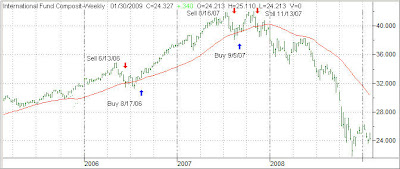 I did not think I would ever see the day that an article would actually admit that the traditional buy-and-hold approach has lost its relevance.
I did not think I would ever see the day that an article would actually admit that the traditional buy-and-hold approach has lost its relevance.
Thanks to reader Nitin for pointing to “The Market’s Latest Victim: Buy-And-Hold Strategy.”
As traditional market signposts lose their relevance, so does the traditional “buy-and-hold” strategy that investors have followed for decades.
Market pros in increasing numbers are eschewing the usual investing strategies and watching technical levels as their guides for making money. They examine temporary market tops and bottoms as guidelines when to sell and buy, and are in many cases utilizing funds rather than individual stocks to make their plays.
Earnings and economic data have proven unreliable to gauge the long-term prospects for the market, which has become a trader’s battlefield. Money that once stayed put for three to five years can now get moved in three to five days or sooner.
“What’s happening is people have learned that if you don’t take a profit it goes away,” says Kathy Boyle, president of Chapin Hill Advisors in New York. “Even somebody who’s really biased towards buy-and-hold is giving up.”
The phenomenon has been on display markedly since earnings season kicked into gear this month.
More than half the company’s in the Standard & Poor’s 500 have beaten earnings expectations, yet the stock index has dropped nearly 7 percent.
The economic data, meanwhile, have been close to expectations.
Friday’s report on fourth-quarter GDP was actually better than what Wall Street predicted-though at a 3.7 percent drop, the numbers were hardly encouraging.
But investors seem to be ignoring the data.
Instead, they’ve turned towards more of a trader’s mentality, pushing the Dow back up when it approaches 8,000 and the S&P; when it falls near 800. It’s a trend that bucks the traditional long-term horizon most investors are supposed to take, but for many it’s working.
“The idea of saying valuations are historically low so we’re just going to buy and hold, that comes at great peril over the next year or two,” says Lee Schultheis, founder and chief investment strategist at AIP Funds in Harrison, N.Y. “But also being overly bearish might also come at peril if the government’s able to get ahead of the curve on the liquidity-credit issue. Once that gets solved equities will have the opportunity to advance.”
Indeed, Boyle has moved nimbly in and out of positions in exchange-traded funds–these days mostly those with a bullish look on the market. She expects a run higher for the market to last into mid-February, when stocks will move lower and Boyle will quit or reverse her positions.
Dealing with the market’s intense moodiness is all part of the job these days.
…
With all of the obstacles facing the market, regaining investor confidence will be critical before buy-and-hold positions become popular again.
[My Emphasis]
It’s clear that most investors and professionals have no idea what they’re doing in this environment. If you’ve lived all of your life with buy-and-hold, there is no way that you can make a sudden sensible adjustment to successfully deal with a bear market.
Read that last paragraph again. If investor confidence is required to go back to buy-and-hold, I can only hope that this confidence will never be regained since it will only cause complacency, which will literally guarantee a repeat disaster once another bear market strikes again; no matter how far that will be in the future.






